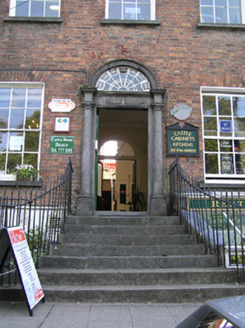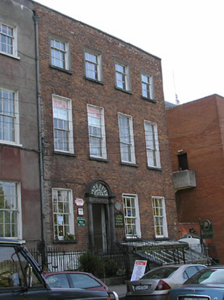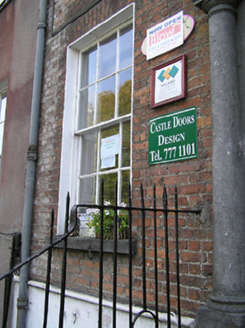Survey Data
Reg No
12001060
Rating
Regional
Categories of Special Interest
Architectural, Artistic, Historical, Social
Original Use
House
In Use As
Shop/retail outlet
Date
1790 - 1795
Coordinates
250765, 155659
Date Recorded
17/06/2004
Date Updated
--/--/--
Description
End-of-terrace four-bay three-storey over part raised basement townhouse with dormer attic, built 1791, on a rectangular plan. Occupied, 1901; 1911. One of a pair. Pitched and hipped slate roofs on L-shaped plans behind parapet, ridge tiles, rendered red brick Flemish bond chimney stacks having stringcourses below capping supporting terracotta pots, and concealed rainwater goods retaining cast-iron octagonal or ogee hopper and downpipe. Red brick Flemish bond wall to front (north) elevation on beaded cushion course on rendered plinth with cut-limestone coping to parapet. Round- or segmental-headed door opening approached by flight of seven cut-limestone steps between wrought iron railings, dragged cut-limestone doorcase with engaged Doric columns on plinths supporting cornice on blind frieze on entablature framing timber panelled door having fanlight. Square-headed window openings with drag edged dragged cut-limestone sills, and red brick voussoirs framing six-over-six (ground floor), nine-over-six (first floor) or three-over-six (top floor) timber sash windows without horns. Interior including (ground floor): hall retaining carved timber surrounds to door openings framing replacement glazed timber doors, and moulded plasterwork cornice to ceiling; segmental-headed door opening into staircase hall with carved timber Classical-style surround framing glazed timber panelled double doors having overlight; staircase hall (south) retaining carved timber surrounds to door openings framing timber panelled doors, staircase on a dog leg plan with timber balusters supporting carved timber banister terminating in ball finial-topped turned timber newel, carved timber surrounds to window openings to half-landing framing timber panelled reveals or shutters, and carved timber surrounds to door openings to landings framing timber panelled doors; room (east) retaining carved timber surround to door opening framing replacement glazed timber door with carved timber surround to window opening framing timber panelled shutters on panelled risers, and moulded plasterwork cornice to ceiling; room (west) retaining carved timber surround to door opening framing replacement glazed timber door with carved timber surrounds to window openings framing timber panelled shutters on panelled risers, and plasterwork cornice to ceiling; and carved timber surrounds to door openings to remainder framing timber panelled doors with carved timber surrounds to window openings framing timber panelled shutters on panelled risers. Street fronted with wrought iron railings to perimeter.
Appraisal
A townhouse erected as one of a pair of houses (including 12001063) representing an important component of the late eighteenth-century domestic built heritage of Kilkenny with the architectural value of the composition confirmed by such attributes as the compact plan form; the asymmetrical façade; the Classically-detailed doorcase not only demonstrating good quality workmanship in a deep grey limestone, but also showing a flower-filled cobweb fanlight; the construction in a handmade red brick; the diminishing in scale of the openings on each floor producing a graduated visual impression; and the parapeted roof. Having been well maintained, the form and massing survive intact together with substantial quantities of the original fabric, both to the exterior and to the interior, including crown or cylinder glazing panels in hornless sash frames: meanwhile, contemporary joinery; and plasterwork refinements, all highlight the artistic potential of a townhouse making a pleasing visual statement in The Parade. NOTE: Occupied (1901) by the civil engineer James Francis Reade (1863-1927) who in 1901 made a survey of Kilkenny Castle for the American millionaire Howard Gould (1871-1959) so that a replica could be erected at Sands Point on Long Island (DIA).





